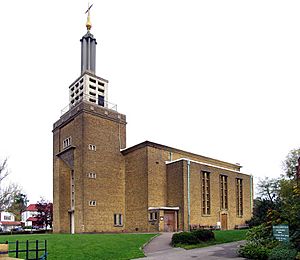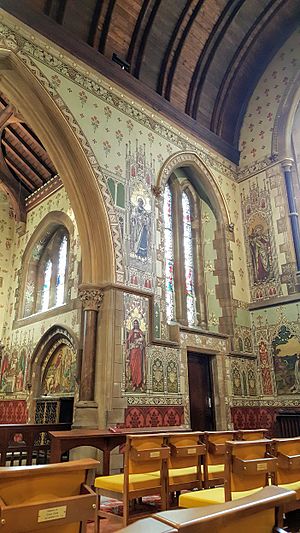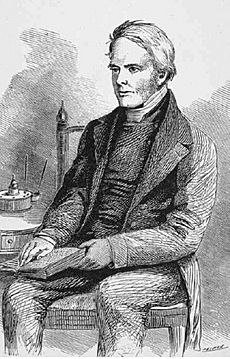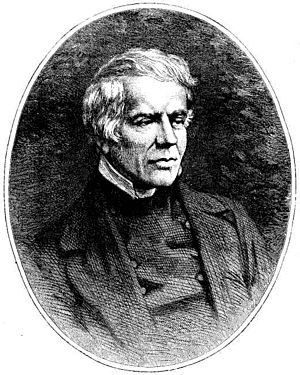John Keble facts for kids
John Keble (born 25 April 1792 – died 29 March 1866) was an English priest and poet. He was one of the main leaders of the Oxford Movement, a religious group in the Church of England. Keble College, Oxford, a famous university college, was named after him.
Quick facts for kids
John Keble
|
|||||||
|---|---|---|---|---|---|---|---|
 |
|||||||
| Born | 25 April 1792 Fairford, England
|
||||||
| Died | 29 March 1866 (aged 73) Bournemouth, England
|
||||||
|
Notable work
|
|
||||||
| Movement | Oxford Movement | ||||||
| Spouse(s) |
Charlotte Clarke
(m. 1835) |
||||||
|
|||||||
| Alma mater | Corpus Christi College, Oxford | ||||||
| Scientific career | |||||||
| Institutions | Oriel College, Oxford | ||||||
Contents
Early Life and Education
John Keble was born on 25 April 1792 in Fairford, England. His father, also named John Keble, was a local priest. John and his brother Thomas were taught at home by their father.
In 1806, John Keble won a scholarship to Corpus Christi College, Oxford. He was a brilliant student. In 1810, he earned top honors in both Latin and mathematics. The next year, he won university awards for his essays. He then became a fellow at Oriel College, Oxford. For several years, he worked as a teacher and examiner at the University of Oxford.
Becoming a Priest
While still at Oxford, Keble became a priest in 1816. He first helped his father as a curate. Later, he worked as a curate in another church in Gloucestershire. In 1823, after his mother passed away, he left Oxford. He moved back to Fairford to live with his father and two sisters.
Between 1824 and 1835, Keble was offered important jobs three times. Each time, he turned them down. He felt he needed to stay with his father and sister. In 1828, he was considered to lead Oriel College, but he was not chosen.
The Christian Year and Poetry
During this time, Keble was writing a book of poems called The Christian Year. This book had poems for Sundays and special church holidays. It was published in 1827. The book helped spread Keble's religious and spiritual ideas. It was meant to help people think and pray during church services.
At first, the book was published without his name. But soon, everyone knew he was the author. In 1831, Keble was made the Oxford Professor of Poetry. He held this job until 1841. Many people called The Christian Year the most popular book of poems in the 1800s. It was a very important part of the Oxford Movement and English literature.
By 1873, over 375,000 copies had been sold in Britain. More than 150 different versions were published. Even though it was very popular then, its fame faded in the 1900s. However, some of its hymns are still well-known today.
At Oxford, Keble met John Coleridge. He learned about the writings of Samuel Taylor Coleridge and William Wordsworth. Keble greatly admired Wordsworth. Wordsworth even offered to help correct the English in The Christian Year. Keble also met Robert Southey, whom he found to be "a noble and delightful character." These writers, especially Wordsworth, helped shape Keble's own poetry.
The Oxford Movement and Hursley
On 14 July 1833, Keble gave a famous sermon called "National Apostasy". This sermon helped start the Oxford Movement. This movement was also known as the Tractarian movement. It was a group of Church of England leaders who wanted to bring back older Christian traditions.
Keble wrote seven articles for Tracts for the Times. These were short papers about faith and church practices. He became a key leader in the movement, along with John Henry Newman and Edward Pusey. However, Keble did not follow Newman when he left the Church of England to join the Roman Catholic Church.
In 1835, Keble's father died. Keble and his sister moved from Fairford. That same year, Keble got married. He was offered the job of vicar (priest) in Hursley, Hampshire, and he accepted. In 1836, he moved to Hursley. He stayed there for the rest of his life, serving as a parish priest at All Saints' Church.
In 1841, his neighbor, Charlotte Mary Yonge, wrote The Child's Christian Year. This book had hymns for Sundays and holy days. Keble contributed four poems to it, including Bethlehem, above all cities blest. In 1857, Keble wrote an important work supporting George Denison, who was criticized for his views on the Eucharist (Holy Communion).
Other Important Writings
In 1830, Keble published his version of Hooker's Works. In 1838, he began to edit the Library of the Fathers with Edward Bouverie Pusey and John Henry Newman. A book of his sermons, Academical and Occasional Sermons, came out in 1847. He also wrote a Life of Wilson, Bishop of Sodor and Man. After he died, his Letters of Spiritual Counsel and 12 books of Parish Sermons were published.
Many of his poems became popular hymns. Some well-known ones include "The Voice that Breathed o'er Eden", "Sun of my soul, Thou Saviour dear", Blest are the pure in heart, and New every morning is the love.
Keble was writing Lyra Innocentium when he faced a great sadness. His friend Newman decided to leave the Church of England for Catholicism. This was a very difficult time for Keble.
Death and Legacy
Keble passed away in Bournemouth on 29 March 1866. He had gone there to try and get better from a long illness, believing the sea air would help. He is buried in All Saints' churchyard in Hursley.

People remember John Keble as a humble and kind person. He was not interested in power or fame. He was shy with strangers but happy and playful with his friends. His friends said he had "clear, brilliant, penetrating eyes."
The Church of England remembers John Keble on 14 July, the day of his famous sermon. He is also remembered on 29 March, the day he died, in other Anglican churches. Keble College, Oxford, was founded in his memory. John Keble Church, Mill Hill, and an old stone bridge over the River Leach are also named after him.
The view from Bulverton Hill in Sidmouth is said to have inspired some of his best poems. He often visited this hill, which has a wide view of the valley and Dartmoor. A wooden bench there, known as Keble's Seat, marks his favorite spot.

A special stained-glass window in St Peter's Church, Bournemouth, was made to honor Keble. He liked to sit in that part of the church during his last months. Later, in 1906, that area became the Keble Chapel.
Many books have been written about John Keble's life. One author, John Taylor Coleridge, said that The Christian Year was "wonderfully scriptural." He believed Keble's mind was so filled with the Bible that its language flowed into his poetry naturally.
See also
 In Spanish: John Keble para niños
In Spanish: John Keble para niños




